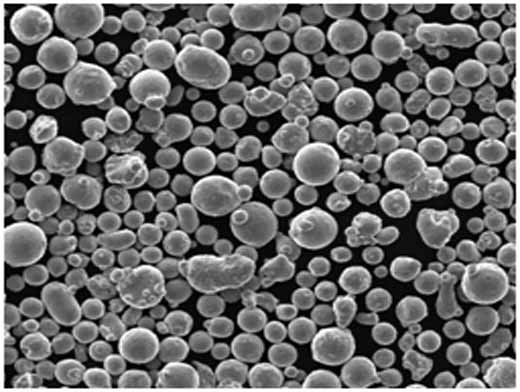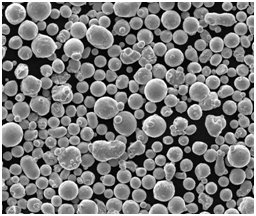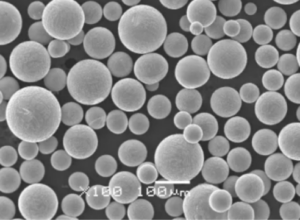لمحة عامة
مسحوق النحاس النقي (Cu) هو مسحوق معدني ذو قيمة عالية لموصلته الممتازة وقابليته للطرق وتعدد استخداماته في التطبيقات الصناعية. نظرًا لنقاوته العالية، مسحوق Cu النقي هو مكون أساسي في مجالات مثل الإلكترونيات والمعادن والتصنيع الإضافي والعمليات الكيميائية. مع تركيبة نموذجية تتجاوز 99.5٪ من النحاس النقي، يوفر هذا الشكل المسحوق من النحاس للمهندسين والمصنعين والباحثين مادة قيمة ذات سمات فريدة.
ما الذي يجعل مسحوق Cu النقي ذا قيمة حقًا؟ مزيج من الخصائص: الموصلية الكهربائية والحرارية العالية، والليونة، والقدرة على مزجها مع مواد أخرى أو تشكيلها في مجموعة متنوعة من الأشكال. سواء كنت تتطلع إلى إنتاج مكونات إلكترونية معقدة أو أجزاء هيكلية متينة، فإن مس

تكوين مسحوق النحاس النقي
يتكون مسحوق النحاس النقي بشكل أساسي من النحاس (Cu) في شكل مطحون بدقة. ومع ذلك، اعتمادًا على التطبيق، قد توجد اختلافات طفيفة في مستويات النقاء وحجم الجسيمات وشكلها، مما يسمح للمصنعين بتكييف المسحوق وفقًا للاحتياجات المحددة. إليك تفصيل:
| المكوّن | التركيبة النموذجية (%) |
|---|---|
| النحاس (النحاس) | ≥ 99.5 |
| الأكسجين (O) | < 0.3 |
| الحديد (Fe) | < 0.05 |
| الشوائب الأخرى | < 0.15 |
يضمن مستوى النقاء هذا الأداء الأمثل، خاصة في التطبيقات الإلكترونية والتوصيلية حيث تكون الخصائص الكهربائية للنحاس حاسمة. تتم معالجة معظم مساحيق النحاس النقي باستخدام تقنيات الانحلال الذري، مما يسمح بالتحكم الدقيق في حجم وشكل الجسيمات، وبالتالي التأثير على خصائص مثل القابلية للتدفق والضغط.
خصائص مسحوق Cu النقي
لتقدير القدرات الكاملة لمسحوق النحاس النقي، دعنا نستكشف خصائصه الأساسية. يلعب كل خاصية دورًا حيويًا، مما يؤثر على كيفية تصرف المسحوق في التطبيقات المختلفة.
| الخصائص | الوصف |
|---|---|
| التوصيل الكهربائي | تعتبر موصلية النحاس الثانية بعد الفضة، مما يجعل مسحوق النحاس النقي فعالًا للغاية في التطبيقات الإلكترونية والإدارة الحرارية. |
| التوصيل الحراري | مع التوصيل الحراري الممتاز، يشتت مسحوق النحاس النقي الحرارة بكفاءة، وهو أمر بالغ الأهمية في الإلكترونيات والمبادلات الحرارية. |
| الليونة | تسمح المطيلية بتشكيل مسحوق النحاس النقي وإعادة تشكيله دون تكسر، وهو مثالي للتصنيع المضاف وعلم الفلزات. |
| مقاومة التآكل | في حين أن النحاس يطور طبقة أكسيد سطحية، فإن مسحوق النحاس النقي يقاوم التآكل الأعمق، مما يحمي الوظائف الأساسية في البيئات المختلفة. |
| مورفولوجيا الجسيمات | يؤثر الشكل المورفولوجي، الكروي أو غير المنتظم عادة، على القابلية للتدفق والكثافة وكيفية امتزاج المسحوق أو تجمعه داخل القوالب أو العمليات الإضافية. |
| الكثافة | تبلغ كثافة مسحوق النحاس النقي حوالي 8.96 جم/سم³، مما قد يؤثر على كيفية اختلاطه أو انضغاطه، خاصة في التطبيقات عالية الكثافة. |
| نقطة الانصهار | يذوب النحاس عند 1084 درجة مئوية، مما يمنحه ثباتًا عاليًا في درجة الحرارة، وهو أمر ضروري في عمليات التلبيد وقولبة حقن المعادن. |
شكل وحجم الجسيمات في مسحوق النحاس النقي
يمكن أن يختلف شكل وحجم الجسيمات في مسحوق النحاس النقي، مما يؤثر على خصائص مثل معدل التدفق والضغط وحتى سلوك التلبيد. فيما يلي الأشكال الأكثر شيوعًا وتأثيراتها:
| شكل الجسيمات | الوصف | التطبيقات |
|---|---|---|
| كروي | يوفر تدفقًا وكثافة تعبئة موحدين، وهو مثالي للطباعة ثلاثية الأبعاد والطلاءات. | يستخدم بشكل متكرر في علم المعادن المسحوقي والتصنيع المضاف لترسيب طبقة متسقة. |
| غير منتظم | يوفر مساحة سطح أكبر، مما يعزز الترابط في المواد المركبة أو المركبات. | مفضل في التطبيقات التي تتطلب رابطة قوية أو تشابك ميكانيكي مع مواد أخرى. |
| رقائق | جزيئات رقيقة ومسطحة تزيد من ملامسة السطح. | غالبًا ما تستخدم في الطلاءات والأصباغ الموصلة، حيث تكون التغطية والتوصيل أمرًا بالغ الأهمية. |
تطبيقات مسحوق النحاس النقي
يجد مسحوق النحاس النقي نفسه في عدد لا يحصى من الصناعات، حيث تستغل كل منها خصائصه المحددة. إليك نظرة على تطبيقاته الأساسية:
| الصناعة | طلب | لماذا مسحوق النحاس النقي؟ |
|---|---|---|
| الإلكترونيات | الأحبار الموصلة والدوائر المطبوعة والوقاية من التداخل الكهرومغناطيسي | تعتبر موصلية النحاس مثالية للمكونات الإلكترونية الدقيقة. |
| علم المعادن | علم المعادن المسحوقي والتلبيد واللحام بالنحاس | يتيح شكل المسحوق التشكيل والضغط في أشكال معقدة بقوة ميكانيكية ممتازة. |
| التصنيع الإضافي | الطباعة ثلاثية الأبعاد للأجزاء والنماذج الأولية الوظيفية | تناسب قابلية تدفق مسحوق النحاس النقي وقابليته للطرق إنتاج التصميم المعقد والسلامة الهيكلية. |
| السيارات | المصارف الحرارية ومواد الاحتكاك وخلايا الوقود | يشتت مسحوق النحاس النقي الحرارة بشكل فعال، مما يجعله خيارًا ممتازًا للإدارة الحرارية للسيارات وحلول الطاقة. |
| الصناعة الكيميائية | المحفزات والطلاءات الموصلة | يعزز تفاعل النحاس مع مركبات معينة والتوصيل الممتاز التفاعلات الكيميائية ومتانة المنتج. |
| الأجهزة الطبية | الأسطح والغرسات المضادة للميكروبات | يتمتع النحاس بخصائص طبيعية مضادة للميكروبات، وهو أمر بالغ الأهمية في المعدات الطبية لتقليل مخاطر العدوى. |






مواصفات وأحجام ودرجات ومعايير مسحوق النحاس النقي
يمكن أن تساعدك معرفة مواصفات وأحجام ودرجات ومعايير مسحوق النحاس النقي في تحديد المادة المناسبة لمشروع معين. يؤثر النقاء وحجم الجسيمات والشكل بشكل كبير على الأداء في كل تطبيق.
| المواصفات | التفاصيل |
|---|---|
| النقاء | ≥ 99.5% (غالبًا ما يصل إلى 99.9% للتطبيقات المتطورة) |
| حجم الجسيمات | تتراوح من النطاق النانوي (<100 نانومتر) إلى الميكرونات (حتى 100 ميكرومتر) |
| الكثافة | 8.96 جم/سم³ |
| نقطة الانصهار | 1084 درجة مئوية |
| التوصيلية | ما يقرب من 5.96 × 10^7 S/m |
| الدرجات القياسية | ASTM B212، ASTM B848، ISO 4287 |
| علم الصرف | متوفر بأشكال كروية ورقائقية وغير منتظمة |
تتوافق كل من هذه الدرجات والمواصفات مع المعايير الدولية مثل ASTM و ISO، مما يضمن أن المسحوق يلبي متطلبات الأداء العالي. إليك تفصيل للأحجام والدرجات الشائعة:
الأحجام والدرجات الشائعة
| الصف | النقاء (%) | نطاق حجم الجسيمات النموذجي (ميكرومتر) | الأفضل للتطبيقات |
|---|---|---|---|
| CP1 | 99.5 | 10-45 | الأحبار الموصلة والدوائر المطبوعة |
| CP2 | 99.8 | 20-60 | علم المعادن المسحوقي والتلبيد |
| CP3 | 99.9 | 1-15 | المحفزات والطلاءات المتخصصة |
| Nano-Cu | 99.9 | <0.1 | الإلكترونيات المتقدمة وتكنولوجيا النانو |
| Flake Cu | 99.5 | 15-45 | الدهانات الموصلة والوقاية من التداخل الكهرومغناطيسي |
| Spherical Cu | 99.7 | 20-100 | التصنيع المضاف والطباعة ثلاثية الأبعاد |
مزايا وقيود مسحوق النحاس النقي
يوفر اختيار مسحوق النحاس النقي على مساحيق المعادن الأخرى مثل الفضة أو الألومنيوم أو حتى النيكل مزايا فريدة، ولكن هناك أيضًا بعض القيود التي يجب مراعاتها. إليك تحليل مقارن:
| أسبكت | مزايا مسحوق النحاس النقي | قيود مسحوق النحاس النقي |
|---|---|---|
| التوصيلية | موصلية كهربائية وحرارية فائقة (قريبة من الفضة) | أقل من الفضة، ولكن أعلى بكثير من الألومنيوم أو النيكل |
| التكلفة | أقل تكلفة من الفضة مع توفير توصيلية مماثلة | أكثر تكلفة من الألومنيوم، خاصة للدرجات عالية النقاء |
| المرونة | شديد الليونة، مما يجعله مناسبًا للقولبة والتشكيل | يمكن أن تؤدي المطيلية إلى التشوه تحت الضغط |
| مقاومة التآكل | مقاومة جيدة للتآكل في البيئات غير الحمضية | عرضة للأكسدة، مما يؤثر على توصيلية السطح |
| التوفر | متوفر على نطاق واسع في مختلف الدرجات وأحجام الجسيمات والأشكال | قد تكون بعض الأحجام والأشكال المتخصصة أكثر تكلفة |
| التفاعل | أقل تفاعلية من المعادن الأخرى في البيئات المعتدلة | يمكن أن يتفاعل مع مواد كيميائية معينة، مما يحد من استخدامه في بعض التطبيقات |
أفضل نماذج مسحوق النحاس النقي وتطبيقاتها المحددة
دعنا نتعمق في بعض أفضل نماذج مسحوق النحاس النقي المتاحة حاليًا، كل منها مصمم لتطبيقات صناعية محددة. يقدم كل نموذج ميزات فريدة، مصممة لتلبية متطلبات عمليات معينة، من الطباعة ثلاثية الأبعاد عالية الدقة إلى الطلاءات الموصلة والإلكترونيات عالية الأداء.
| الطراز | النقاء | حجم الجسيمات (ميكرومتر) | الشكل | التطبيقات المثالية |
|---|---|---|---|---|
| Cu-Powder CP1 | 99.5% | 10-45 | غير منتظم | الأحبار الموصلة والدوائر المطبوعة والتطبيقات الإلكترونية الأساسية |
| Cu-Powder CP2 | 99.8% | 20-60 | كروي | مناسب لعلم المعادن المسحوقي والتلبيد بسبب قابليته للتدفق |
| Cu-Powder CP3 | 99.9% | 1-15 | رقائق دقيقة | الطلاءات الموصلة المتطورة والمكونات الإلكترونية المتخصصة |
| Nano-Cu 99.9 | 99.9% | <0.1 | نانو | الأجهزة الإلكترونية المتقدمة وأجهزة الاستشعار وتكنولوجيا النانو والتحفيز |
| Cu-Sph 45 | 99.7% | 15-45 | كروي | الطباعة ثلاثية الأبعاد والتصنيع المضاف وتصنيع الأجزاء الدقيقة |
| Cu-Flake 99.5 | 99.5% | 15-45 | رقائق | الدهانات الموصلة والوقاية من التداخل الكهرومغناطيسي والطلاءات التي تتطلب تغطية مساحة سطح كبيرة |
| Cu-Powder 80 | 99.8% | 45-80 | كروي | مثالي للأجزاء الهيكلية في التصنيع المضاف بسبب الكثافة والقوة |
| High-Purity Cu 100 | 99.99% | 10-30 | كروي | الإلكترونيات عالية الأداء، خاصة في الأجهزة الحساسة أو المصغرة |
| Cu-Powder M10 | 99.7% | 10-50 | مختلط | تستخدم في قطع غيار السيارات وخلايا الوقود ومواد الاحتكاك |
| Cu-Catalyst 99.8 | 99.8% | 1-5 | مسحوق ناعم | متخصص في الصناعة الكيميائية والصيدلانية للتطبيقات التحفيزية |
الموردون ومعلومات التسعير لـ مسحوق Cu النقي
تعتبر الأسعار وتوافر الموردين أمرًا بالغ الأهمية عند التخطيط لاستخدام مسحوق النحاس النقي في التطبيقات واسعة النطاق. يوجد أدناه جدول يقارن بين الموردين الشائعين ومنتجاتهم ونطاقات الأسعار التقريبية، والتي يمكن أن تختلف بناءً على الكمية ومتطلبات الدرجة المحددة.
| المورد | توفر النموذج | التسعير (تقريبي) | التعليقات |
|---|---|---|---|
| العناصر الأمريكية | CP1، CP2، Nano-Cu، Spherical | 50-200 دولار أمريكي/كجم | معروف بمسحوق عالي النقاء؛ تغيير الحجم حسب الطلب |
| Goodfellow Corporation | High-Purity Cu، Nano-Cu | 150-400 دولار أمريكي/كجم | نماذج متطورة للأجهزة الطبية والإلكترونيات المتقدمة |
| Metal Powder Co. Ltd. | CP3، Flake Cu | 70-150 دولار أمريكي/كجم | تقدم أحجامًا كبيرة وخيارات تغيير الحجم المرنة |
| SkySpring Nanomaterials | Nano-Cu، High-Purity Cu | 250-500 دولار أمريكي/كجم | متخصص في المواد النانوية؛ أسعار مميزة |
| الاختيارات | Spherical Cu | 80-220 دولار أمريكي/كجم | مجموعة كبيرة للتصنيع المضاف |
| Nanografi Nano Technology | Cu-Catalyst، Nano-Cu | 200-450 دولار أمريكي/كجم | معروف بمساحيق الدرجة البحثية ذات النقاء العالي |

التعليمات
| سؤال | الإجابة |
|---|---|
| ما هو استخدام مسحوق النحاس النقي؟ | يستخدم مسحوق النحاس النقي في المقام الأول في الإلكترونيات وعلم المعادن والتصنيع المضاف وقطع غيار السيارات وكمحفز في الصناعة الكيميائية. |
| لماذا يفضل مسحوق النحاس في الإلكترونيات؟ | يوفر مسحوق النحاس توصيلية كهربائية وحرارية ممتازة، وهو أمر ضروري للأحبار الموصلة والدوائر المطبوعة والوقاية من التداخل الكهرومغناطيسي في المكونات الإلكترونية. |
| كيف يتم إنتاج مسحوق النحاس النقي؟ | يتم تصنيعه بشكل شائع من خلال الانحلال الذري، حيث يتم تفريق النحاس المنصهر إلى قطرات دقيقة تبرد وتتصلب في شكل مسحوق، مما يتحكم في الحجم والشكل. |
| ما هي أشكال الجسيمات المتاحة، ولماذا تهم؟ | تشمل الأشكال المتاحة الكروية والرقائقية وغير المنتظمة. تتدفق الجسيمات الكروية بشكل أفضل وتتراكم بكثافة، وهي مثالية للطباعة ثلاثية الأبعاد، بينما توفر الرقائق مساحة سطح أكبر للطلاءات. |
| ما هي فوائد مسحوق النحاس عالي النقاء؟ | يوفر مسحوق النحاس عالي النقاء (99.9% أو أعلى) توصيلية أفضل وشوائب أقل، وهو أمر ضروري للتطبيقات الحساسة مثل الإلكترونيات |
| هل مسحوق النحاس آمن في التعامل؟ | نعم، مع الاحتياطات القياسية مثل ارتداء القفازات والأقنعة. مسحوق النحاس غير سام، لكن استنشاق الجسيمات الدقيقة يمكن أن يكون ضارًا، لذا ينصح بالتحكم في الغبار. |
| هل يمكن أن يتأكسد مسحوق النحاس، وكيف يؤثر ذلك على التطبيقات؟ | نعم، يمكن أن يتأكسد مسحوق النحاس، خاصة في الرطوبة العالية. قد يؤثر الأكسدة على الموصلية، لذلك غالبًا ما يتم تخزين المساحيق في بيئات منخفضة الأكسجين أو معالجتها بطلاءات واقية. |
| ما هي المعايير الرئيسية لمسحوق النحاس؟ | تشمل المعايير ASTM B212 و ASTM B848 و ISO 4287، والتي تحدد الجودة والنقاء وحجم الجسيمات والمواصفات الأخرى، مما يضمن استيفائها للمتطلبات الصناعية. |
| كيف يتم قياس حجم الجسيمات، ولماذا هو مهم؟ | يتم قياس حجم الجسيمات باستخدام حيود الليزر أو المجهر. يؤثر الحجم على قابلية التدفق وكثافة التعبئة والمساحة السطحية، مما يؤثر على الأداء في تطبيقات معينة. |
| من أين يمكنني شراء مسحوق النحاس النقي، وما الذي يجب أن أفكر فيه؟ | يقدم العديد من الموردين مثل American Elements و Goodfellow و Valimet مسحوق النحاس النقي. عند الشراء، ضع في اعتبارك النقاء وحجم الجسيمات والتطبيق المقصود وسمعة المورد. |
| كيف يقارن مسحوق النحاس بمسحوق المعادن الأخرى مثل الفضة أو النيكل؟ | النحاس موصل للغاية وأقل تكلفة من الفضة. إنه أكثر توصيلًا من النيكل ولكنه يتمتع بمقاومة تآكل أقل، مما يجعله مناسبًا للتطبيقات الموصلة الحساسة للتكلفة. |
| هل يمكن استخدام مسحوق النحاس النقي في الطباعة ثلاثية الأبعاد؟ | بالتأكيد! يستخدم مسحوق النحاس النقي الكروي على نطاق واسع في الطباعة ثلاثية الأبعاد للمعادن نظرًا لقابليته الممتازة للتدفق وكثافته، وهو مثالي لتشكيل أجزاء قوية ومفصلة. |
| هل مسحوق النحاس قابل لإعادة التدوير؟ | نعم، مسحوق النحاس قابل لإعادة التدوير، مما يجعله صديقًا للبيئة. غالبًا ما يمكن تنقية الخردة أو المسحوق غير المستخدم وإعادة استخدامه في تطبيقات أخرى. |

